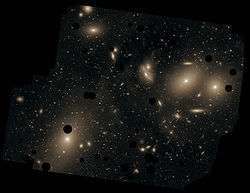NGC 4473
NGC 4473 is an elliptical galaxy[2] located about 50 million light-years away[3] in the constellation of Coma Berenices.[4] It was discovered by astronomer William Herschel on April 8, 1784.[5] NGC 4473 has an inclination of about 71°.[6] NGC 4473 is a member of a chain of galaxies called Markarian's Chain which is part of the larger Virgo Cluster of galaxies.[7][8]
| NGC 4473 | |
|---|---|
 SDSS image of the elliptical galaxy NGC 4473. | |
| Observation data (J2000 epoch) | |
| Constellation | Coma Berenices |
| Right ascension | 12h 29m 48.9s[1] |
| Declination | 13° 25′ 46″[1] |
| Redshift | 0.007485[1] |
| Helio radial velocity | 2244 km/s[1] |
| Distance | 52.74 Mly |
| Group or cluster | Virgo Cluster |
| Apparent magnitude (V) | 11.16[1] |
| Characteristics | |
| Type | E5[1] |
| Size | ~ 68.5 kly (estimated); 21 kpc[1] |
| Apparent size (V) | 4.5' × 2.5'[1] |
| Other designations | |
| CGCG 70-125, MCG 2-32-93, PGC 41228, UGC 7631, VCC 1231[1] | |
Globular Clusters
NGC 4473 has an estimated population of 376 ± 97 globular clusters.[9] The clusters may have formed from the result of multiple minor mergers that helped form the outer regions of the galaxy.[3]
Counter–rotating features
NGC 4473 has two counter-rotating stellar discs embedded in the inner regions of the galaxy. They may have formed from the accretion of gas from outside the galaxy, or by the mergers of gas-rich galaxies.[3]
Supermassive Black Hole
Using the HST and spectroscopic data from the ground to measure the motions of stars in the center of the galaxy, Douglas Richstone and colleagues at the University of Michigan have concluded that NGC 4473 has a supermassive black hole[10] with an estimated mass of roughly 100 million solar masses (1×108 M☉).[11][12] Its diameter is estimated to be around 4.459 astronomical units (415 million mi).[13]
See also
- List of NGC objects (4001–5000)
- Messier 87
- M86
- NGC 4550 - Lenticular galaxy in the Virgo Cluster experiencing counter-rotation
Other Images
 Image of the central region of the Virgo cluster of galaxies. NGC 4473 is in the upper-left central portion of the image.
Image of the central region of the Virgo cluster of galaxies. NGC 4473 is in the upper-left central portion of the image. The elliptical galaxy NGC 4473 as imaged by the HST.
The elliptical galaxy NGC 4473 as imaged by the HST.
References
- "NASA/IPAC Extragalactic Database". Results for NGC 4473. Retrieved 2017-08-01.
- "Your NED Search Results". ned.ipac.caltech.edu. Retrieved 2017-08-01.
- Alabi, Adebusola B.; Foster, Caroline; Forbes, Duncan A.; Romanowsky, Aaron J.; Pastorello, Nicola; Brodie, Jean P.; Spitler, Lee R.; Strader, Jay; Usher, Christopher (25 June 2015). "The SLUGGS Survey: Globular cluster kinematics in a "double sigma" galaxy - NGC 4473". Monthly Notices of the Royal Astronomical Society. 000 (2): 2208. arXiv:1506.07882v1. Bibcode:2015MNRAS.452.2208A. doi:10.1093/mnras/stv1426.
- Rojas, Sebastián García. "Galaxy NGC 4473 - Galaxy in Coma Berenices Constellation · Deep Sky Objects Browser". DSO Browser. Retrieved 2017-08-01.
- "New General Catalog Objects: NGC 4450 - 4499". cseligman.com. Retrieved 2017-08-01.
- Schulze, Andreas; Gebhardt, Karl (1 March 2011). "EFFECT OF A DARK MATTER HALO ON THE DETERMINATION OF BLACK HOLE MASSES". The Astrophysical Journal. 729:21 (1): 21. arXiv:1011.5077. Bibcode:2011ApJ...729...21S. doi:10.1088/0004-637X/729/1/21.
- "Exploring the Coma-Virgo Cloud" (PDF). GEMINI. 2:12: 1–9. April 1978.
- French, Sue (2004). "Deep-Sky Wonders: Markarian's Chain". Sky & Telescope. 107 (5): 88–91.
- Rhode, Katherine L. (2012). "Exploring the Correlations between Globular Cluster Populations and Supermassive Black Holes in Giant Galaxies". The Astronomical Journal. 144 (5): 154. arXiv:1210.4570. Bibcode:2012AJ....144..154R. doi:10.1088/0004-6256/144/5/154. ISSN 1538-3881.
- O'Meara, Stephen James (2011-06-30). Deep-Sky Companions: The Secret Deep. Cambridge University Press. ISBN 978-1-139-50007-4.
- "List of black hole candidates". www.johnstonsarchive.net. Retrieved 2017-09-17.
- "NGC 4473 Fact Sheet - StarDate's Black Hole Encyclopedia". blackholes.stardate.org. Retrieved 2017-08-02.
- "Wolfram|Alpha: Computational Knowledge Engine". www.wolframalpha.com. Retrieved 2017-10-28.
External links
| Wikimedia Commons has media related to NGC 4473. |
- NGC 4473 on WikiSky: DSS2, SDSS, GALEX, IRAS, Hydrogen α, X-Ray, Astrophoto, Sky Map, Articles and images